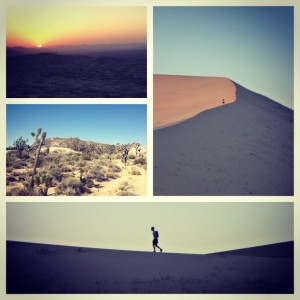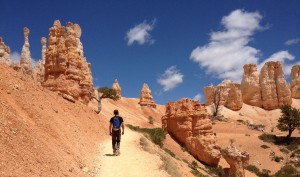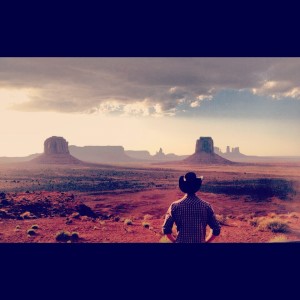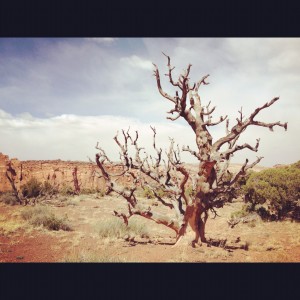Vagabonding Field Reports: roughing it in the Southwest USA
Cost: $50/day
What is the strangest thing you have seen recently?
The South Kaibab trail winds its way from the south rim of the Grand Canyon to the canyon floor, roughly 5000 feet (1525 metres) below. It is extraordinarily beautiful and offers spectacular vistas at various points over its seven miles. Because of the brilliant views and easy access it receives lots of foot traffic. So much traffic, in fact, that the rock squirrels in this ‘wilderness’ have become extremely comfortable around humans. Turn your back to admire the view and your trail mix disappears in the clutches of a clever rodent. Squirrels are intelligent creatures and some have worked out how to suckle from hydration bladders. If you leave your pack on the ground one of the little guys may creep up, grasp the bite valve in its fore paws and start quenching its thirst. Extraordinary.
Some people, particularly up on the heavily visited south rim decide to offer up little morsels to the inquisitive squirrels, an act that can end painfully. The squirrels aren’t above biting the hand that feeds them and there are signs warning tourists as much.
Describe a typical day.
As the sun rises I wake in my sleeping bag and gaze through the tent at the immense rock walls and across the arid landscape. Mojave, Grand Canyon, Capitol reef, Bryce, Zion are all rich in beauty. Upon waking in the American Southwest one is always met with a pleasing view and wonderment inspired by the bizarre, desolate landscape.
The serenity the view brings me is interrupted by a foul odour. I realize my travel buddy Kevin desperately needs a shower. We have been road tripping from one location to the other, car camping and back packing. Showers have been scarce.
Breakfast is a cheap and easy affair. Multi grain cheerios with powdered milk fits the bill. It’s now time to explore. This is best done by foot and started early to avoid the heat. We hike…and hike….and hike. Before it gets too hot, we have covered a few miles and, depending on the day, gazed upon the sprawling sand dunes of Mojave, sheer cliffs of the Grand Canyon, claustrophobic slot canyons of Zion or other-worldly hoodoos of Bryce Canyon.
During the middle part of the day at lower elevations the heat can be intense. If it ‘s going to rise above 100 degrees Fahrenheit (37 degrees Celsius), which it invariably does at this time of the year at the Grand Canyon floor, we rest during the hottest part of the day. From around 10am to 4pm we laze around under the limited amount of shade, cool off in any available streams, eat tortillas for lunch and read something topical. I have borrowed a copy of ‘Over the Edge: Death in the Grand Canyon’ from a rangers station. As the title suggests it describes in detail all the grizzly ways one may expire in and around the Grand Canyon, from extreme heat exhaustion to being pushed from the south rim by a disgruntled spouse. A review on the back describes it as ‘an absolute masterpiece’- it’s no George Orwell but I have a morbid fascination with it. Despite how gripping this ‘masterpiece’ is, I usually fall asleep and take a nap whilst waiting out the heat.
Come 4pm we start hiking again. The visual wonders continue: massive California condors cruise high above us, never flapping their wings as they survey the land for carrion. The sky is a striking blue, noticeably more vivid that the smog tarnished skies of California. White clouds take up curious shapes, seemingly in order to contrast with and enhance the already spectacular horizon.
Upon arriving at our next campsite, we set up the tent and start cooking dinner. As we eat soup or ramen noodles, we discuss all the delightful foods (anything edible that isn’t ramen noodles) we can feast upon when we return to civilization. We are weary after having covered many miles, however before we turn in we look up at the night sky. Unspoiled by light pollution, we see stars, planets and the Milky Way, sights that our urban lives prevent us from seeing regularly. Then we sleep and do it all over again the next day.
Describe an interesting conversation you had with a local.
We met Salt Lake City native, Rob, coming up the Bright Angel trail to the south rim of the Grand Canyon. He had explored much of the South-West and was accompanied by a German vagabond by the name of Sebastian. They had met each other in Canada and had decided to make their way south to explore some more of Rob’s back yard. They had hitchhiked from Canada to Salt Lake City, where they picked up Rob’s car, and were driving it around Utah and Arizona. At one point, as they drove through Utah, they picked up a hitchhiking homeless man who informed them of some free campsites in the area. They ended up sleeping next to him under the stars at Goosenecks state park before saying their goodbyes the next morning.
Neither hitchhiking nor sleeping next to homeless people seemed to bother them, in fact, quite the opposite; they seemed to revel in the excitement of it all. They loved meeting all the strangers who gave them lifts and were of the opinion that the overwhelming majority of people are kind and generous, and the worst thing that could happen to them was that they could be robbed. Maybe it was because I was reading some morbid literature, but I could think of many more violent and horrible outcomes to their actions.
In addition to their mode of travel, they had slept on the floor of the Grand Canyon without permits and swam in the Colorado River. Both of these activities are against park regulations. According to ‘Over the Edge: Death in the Grand Canyon’ swimming in the Colorado, especially without a life jacket, is fraught with danger. The currents are strong and many people are swept into rapids only for their bodies to emerge several miles down stream, bruised, battered and lifeless. Rob and Sebastian, however emerged unscathed, their only complaint being that it was awfully cold. ‘It was zis cold’ Sebastian said, as he parted his thumb and index finger in a gesture indicating the effect of the frigid water on his manhood.
Sleeping a night in the Grand Canyon corridor without permits can get you in a bit of trouble but it’s not overly dangerous….usually. Rob mentioned that they had been bothered by some foxes during the night and I recalled seeing a warning on a bulletin board at camp informing campers that two foxes had recently been shot in the area after displaying unusual and aggressive behaviour. Tests on their brain tissue had confirmed that they were indeed rabid. After informing the two gentleman of their potentially close call with one of the most horrible afflictions known to man, they seemed unconcerned and mildly amused. They then kindly suggested I stop reading horrifying books.
Perhaps it comes down to how your risk-reward meter is calibrated, as blogger Nancy Sathre- Vogel, discussed in a recent post, but I certainly wouldn’t be comfortable doing some of the things Rob and Sebastian do. I will admit that their stories and sense of adventure did inspire me a little and I have resolved to give hitchhiking a try at some point in the future. Its time for a bit of a recalibration, but you won’t find me hunkered down next to a homeless man any time soon.
What do you like about where you are? Dislike?
I like the spell bounding scenery that seems to surround me at every turn of a trail or highway, and the sense of freedom that comes from living out of your car or backpack and winging it.
I dislike the crowds at some of the national parks, especially come weekend time, however this can easily be remedied by hiking away from the main thoroughfares.
Road tripping in the USA at the moment is significantly more expensive than it was a couple of years ago, given the price of petrol. There is no getting around the fact that a large portion of your expenses will go towards this if you are driving vast distances. We tried to stay in the same place for a few days and utilize free shuttle services in the National Parks to reduce costs.
Describe a challenge you faced.
Sleeping in close proximity to Kevin, my malodorous companion, in a tent for an extended period of time has brought its challenges. There is a limit on personal space and we have become down right filthy at times, having showered infrequently. Additionally, it is more of an effort to set up a tent and cook on a portable stove than it is to stay in a hotel/hostel room and buy a cheap dinner. As time goes on we have become more efficient and it doesn’t take us too long to make our shelter and cook. Obviously, we are exposed to the elements more than we would be under a roof. We had to sleep a night in the car at a truck rest stop after our tent kept blowing down one night as high wind gusts hit out campsite. We have been rewarded for the challenge in more ways than one: reduction in costs, splendid views of the night sky and clean air.
What new lesson did you learn?
I have long known that the national park system is one of the USA’s best gifts to its people. Phenomenal beauty abounds in a stunning array of landscapes and unique ecosystems that draw visitors from across the country and the world. Humans have long held a reverence for these wild places and many mountains and peaks bare religious names: Abraham, Isaac and Jacob peaks in Zion, Vishnu temple of the north rim of the Grand Canyon. There are even non denominational religious services held regularly at the south rim of the Grand Canyon.
Despite this adoration, just as a religious person does not spend all their time in a church, temple or mosque, no matter how much we love nature we cannot, nor do we want to, live a nomadic existence and truly return to the wild. It has come to the end of my two week tour of the southwest wilderness and, although I have enjoyed my time thoroughly, and want to explore more, I find myself craving the creature comforts of the urban world; comfortable beds, movie theatres and cheap Mexican food await.
Where next?
Guatemala for a month






June 2nd, 2012 at 5:11 pm
Chipmunks up on the Beartooth Highway in Montana can be as crafty as their four-legged cousins in the Canyon. A few ravens in the Southwest have even learned to unzip tents. I’m quite fond of Zion; my first visit there a bolt of lighting struck a tree less than fifteen feet from me and lit it on fire like a match stick! For the first month of that same trip, I had a human companion along –plus we each had a dog. We both brought our small backpacking tents to have our own space at night. It made a world of difference in our sanity after spending days packed in a small car. For future reference; all Truck stops have public showers, usually between $5 to $7 for your own private bathroom. And, while it’s not the most glamours place to camp over night. You’re allowed to set up a tent or park an RV over night at all 24 hour Wal*Marts for free.
June 3rd, 2012 at 9:40 pm
Great advice!
Ravens are super intelligent. We saw some punching holes in boxes and styrofoam coolers with their beaks to get to the food. Unzipping tents takes it to another level though.
June 5th, 2012 at 4:47 am
Nice post mate. Keep us up-to date with Guat. You should tweet the links to articles also. P